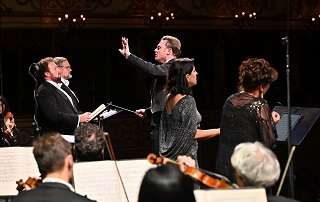|
Back
A Celestial Quartet Parma
Teatro Regio
09/23/2022 - & September 30, 2022
Giuseppe Verdi: Messa da Requiem
Marina Rebeka (soprano), Varduhi Abrahamyan (mezzo), Stefan Pop (tenor), Riccardo Zanellato (bass)
Coro del Teatro Regio di Parma, Martino Faggiani (chorus master), Orchestra Sinfonica nazionale della RAI, Michele Mariotti (conductor)

S. Pop, R. Zanellato, M. Mariotti, V. Abrahamyan, M. Rebeka (© Roberto Ricci)
Verdi’s enduring religious masterwork premiered in 1874, a year after the death of novelist Alessandro Manzoni, a man he immensely admired. The idea was considered earlier by the composer for a requiem mass to be performed in 1869 to commemorate the first anniversary of Rossini’s death. That project involved no less than thirteen composers, of whom Verdi was the most prominent. Among the others were Antonio Bazzini (1818‑1897), Federico Ricci (1809‑1877), Carlo Coccia (1782‑1873) and other now forgotten composers. The project never materialized, mostly due to conductor Angelo Mariani’s lack of enthusiasm, thus ending his long collaboration with Verdi. Rediscovered by musicologist David Rosen, the Messa per Rossini premiered in 1988, helmed by conductor Helmuth Rilling. Verdi’s contribution was the moving final movement, “Libera me,” which was later to be reworked as part of his masterpiece of 1874, Requiem.
Since its first performance, many have argued this work is too operatic to be truly considered sacred. Hans von Bülow, Wagner’s champion and frequent conductor, famously called it “Verdi’s latest opera, though in ecclesiastical robes.” Brahms disagreed, calling it a work of genius. Today, most see it as a sacred work with ostensibly operatic vocal writing. One compelling reason for doubting the work’s religious nature is Verdi’s renowned aversion to the Catholic Church. However, in this he was not alone among artists and intellectuals of the time. It’s true that Verdi had a particular dislike of the clergy and felt judged by them for his living “in sin” with soprano Giuseppina Strepponi for twelve years, until they legally married. In his opera Aida, Amneris’s famous line “Sacerdoti: compiste un delitto... tigri infami di sangue assetate, voi la terra ed i numi oltraggiate... voi punite chi colpe non ha” (Oh priests, you have committed a crime...Wicked tigers, thirsting for blood, you have outraged both heaven and earth...you have punished where there is no guilt) validates that intense aversion to the clergy. However, this son of peasants from deeply Catholic Italy likely maintained some vestiges of faith. Moreover, he was sixty at the time of its composition, an opportunity ripe for reflection on his own mortality that the Requiem afforded him.
The Parma Festival has accomplished a great feat in assembling the ideal cast for Verdi’s Requiem. Not only are all four soloists among today’s most sought‑after opera stars, but they also have the ideal timbres for their parts. Soprano Marina Rebeka is one of the best sopranos working today. She possesses a beautifully distinct timbre; her lyric soprano is powerful enough to extend beyond her Fach with ease. She astounded in “Libera me,” conveying the mysterious plight of the human soul and its desire for deliverance with aplomb.
In several parts of the Requiem, including the moving “Agnus Dei,” she sings extensively with the mezzo. Varduhi Abrahamyan’s rich sound is the exact colour of mezzo to match and contrast with the soprano’s. Several sections sung by Abrahamyan were reminiscent of Amneris’s part in Aida and sounded quite operatic. This is not surprising, as Aida was then Verdi’s most recent work, and this again explains why some find this work more operatic than sacred.
Stefan Pop is among today’s most prominent lyric tenors. While he’s known for his Donizetti and Bellini roles, he has recently been singing heavier Verdi and Puccini roles. His bel canto training has produced inspired elegance and impeccable phrasing. His lyric tenor also matches the right timbre for the part. In “Ingemisco” he utterly shone, thanks to his brilliant voice and his evident passion to properly serve this profound music. This movement, showing man’s humility facing God, requires the utmost sensitivity while producing a light timbre, allowing the ethereal majesty of the work to reveal itself. A darker voice would defy this purpose.
Though his voice is not an overpowering one, bass Riccardo Zanellato imbued in his part a noble sound. This Verdian bass is unfailingly elegant and poised. Some interpret the four voices as the four aspects of humanity: the bass as wisdom, gravitas and judgement; the tenor, conjuring man in his endeavours; the mezzo, conveying love and sensuality; and the soprano, the fragile human soul. When we look at the symbolism attributed to these voices in Verdi’s Requiem, it’s clear there is veracity in that interpretation.
Conductor Michele Mariotti led the Orchestra Sinfonica nazionale della RAI with gusto. The Requiem is a work he has toured with this very orchestra for years, and this is evident in the playing. It’s clear his appreciation and understanding of the work has evolved over time and has been passed on to the orchestra. He was especially thrilling in the recurring choral movement, “Dies Irae.” One truly felt the Heavens opening. The second reprise of the “Dies Irae” was truly terrifying. The least brilliant part was the “Sanctus,” an eight‑part fugue for two choirs. Its relative blandness made the following “Agnus Dei” more grand and inspired. The sung melody was passed between the soloists and the chorus, and later joined by the orchestra, to tremendous effect. The last movement, “Libera me,” was the glorious highlight of the evening, thanks to Marina Rebeka’s evocatively emotional interpretation.
Ossama el Naggar
|